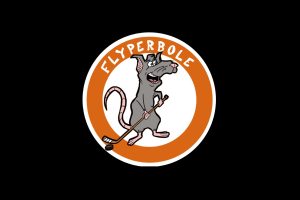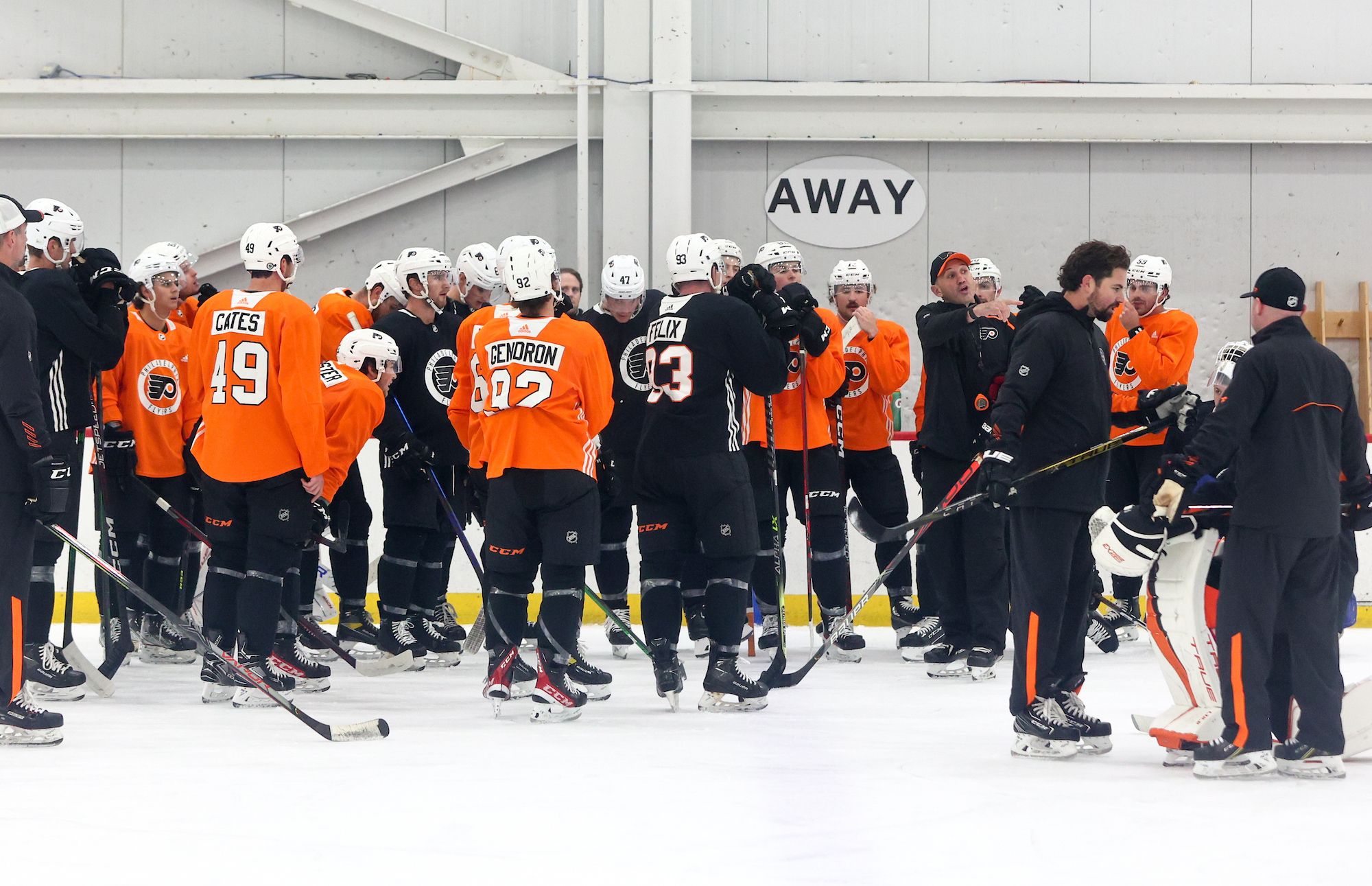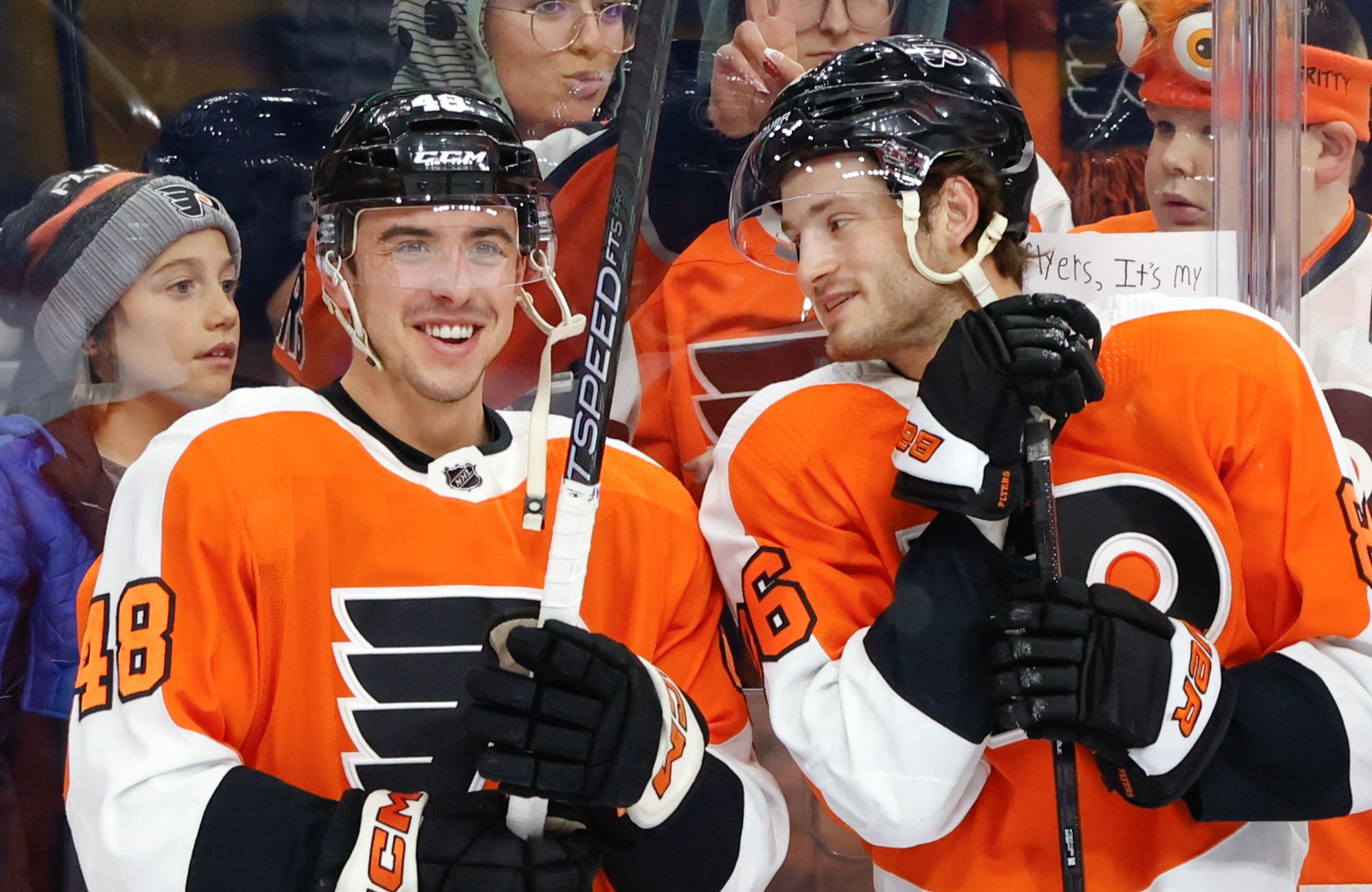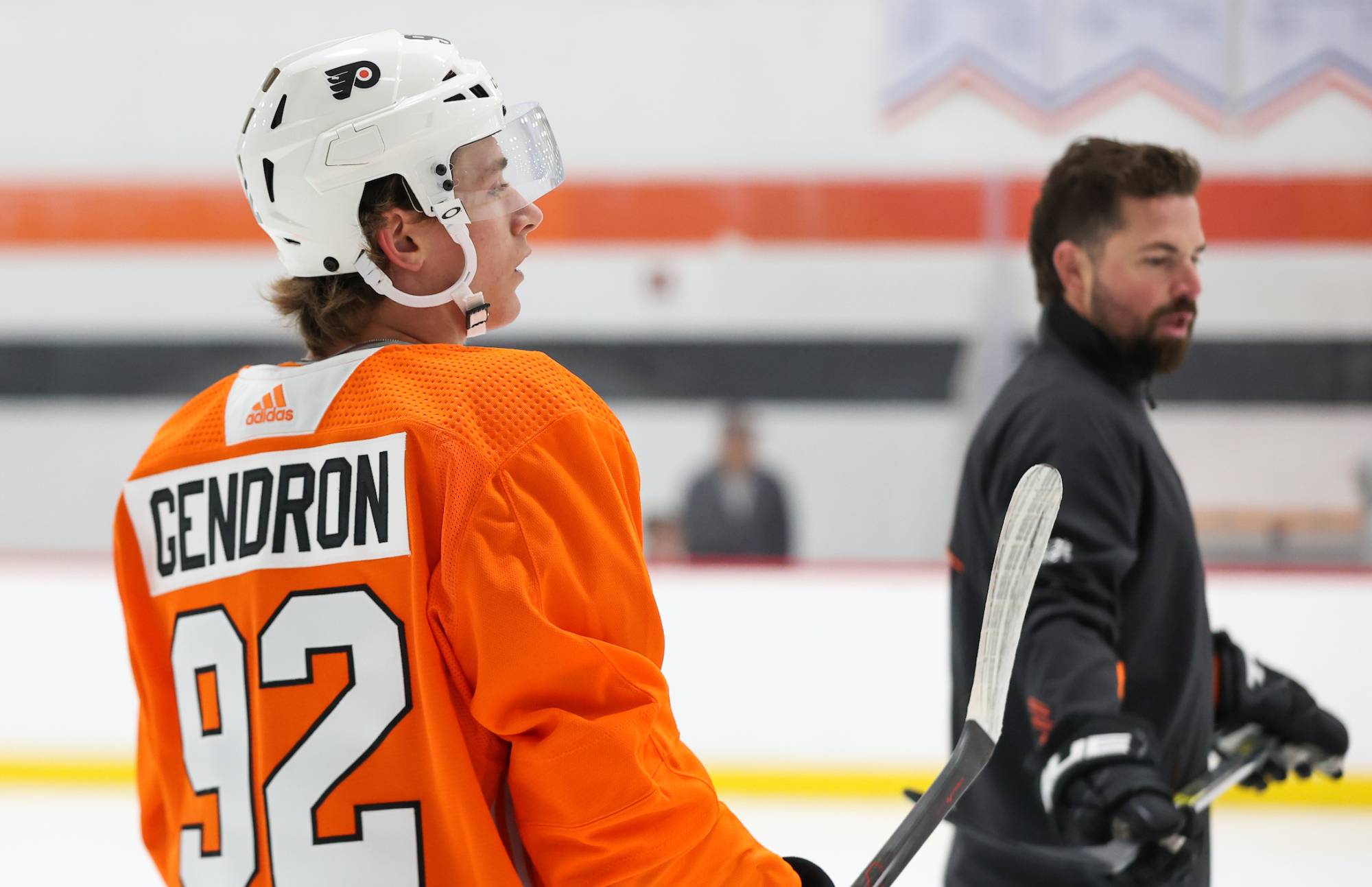Morning Observations is a feature where we break down the previous night’s game with an analytical eye.
#1: After exploiting bad goaltending on Saturday, Flyers stymied by a great one
In their victory over the Carolina Hurricanes this past weekend, the Philadelphia Flyers did not drive play at 5v5 despite the positive result. The good news was that territorial dominance is not a prerequisite for beating the Canes — the team’s poor goaltending provides an obvious alternative route to a win. Against the Montreal Canadiens, however, a repeat of that strategy is doomed to fail considering the presence of Carey Price, one of the league’s best netminders.
To the Flyers’ credit, they hung right with Montreal at 5v5, winning the score-adjusted shot attempts battle (55.5% Corsi) and just narrowing losing in xG (46.55%). But even with Steve Mason performing admirably for Philadelphia, that wasn’t enough to top the Price-led Canadiens, as the Montreal goalie stopped 31 of 32 shots for a stellar 0.969 save percentage. Despite their strong start to the year, the Canadiens have flaws — their defense isn’t particularly deep and Michal Therrien’s on-ice tactics have historically failed to drive play at even strength. But Carey Price is fully capable of masking those weaknesses on a nightly basis. He’s just that good, and the Flyers were reminded of that fact last night.
#2: Second line continues to roll
On Saturday night, the Flyers’ second line of Jakub Voracek, Sean Couturier and Travis Konecny was the team’s most effective unit, consistently generating chances and driving controlled zone entries. However, at times it did feel like a one-man show, as the reinvigorated Voracek seemed to be the one creating the vast majority of the offense on the line. Last night, the second unit again played like a top line, but this time Couturier and Konecny were just as impressive as Jake.
Voracek continued his comeback tour, scoring his third goal of the season on a picture-perfect redirection of a Claude Giroux shot. His linemates were just as impressive, however. Konecny was a controlled entry machine, using his dazzling speed to blast through the neutral zone and get in on the attack. Couturier, on the other hand, was the stabilizing presence in all three zones, finishing with a team-high 71.37% score-adjusted Corsi at 5v5. Right now, the Konecny-Couturier-Voracek trio may be the “second” line in name, but it’s clearly been the Flyers’ most dangerous unit.
NHL.com Report & Highlights | Corsica.Hockey Game Recap Page | HockeyStats.ca Recap | NaturalStatTrick Recap | HockeyViz.com | BSH Recap | Meltzer’s Musings
#3: Even in defeat, Mason played very well
Over the past two games, Steve Mason has given up five goals — far from an awful goals against rate, but not one that will immediately turn any heads either. But in this case, the raw numbers don’t do Mason justice. He made a number of high-difficulty saves against the Hurricanes to help the Flyers overcome their mediocre 5v5 play, and last night he was on his game yet again.
His two huge stops in the first period against Phillip Danault and Paul Byron kept the game scoreless and prevented Philadelphia from falling into an early hole, while his point-blank save on David Desharnais in front with just two minutes left kept his team’s comeback hopes alive for just a bit longer than they should have survived. Mason may not have gotten the win, but he justified his coach’s confidence in choosing him for a tough road matchup despite it being his third straight start. Michal Neuvirth will almost certainly play in tonight’s game against the Buffalo Sabres, but that doesn’t change the fact that Mason is staking a very strong claim to the top spot on the goalie depth chart.
#4: Penalty kill actually wasn’t bad — except for right after faceoffs
Yesterday, I outlined the changes that the Flyers’ coaching staff has made this season to the team’s penalty kill, which was such a liability in the 2015-16 regular season and (especially) the playoffs. By reintroducing defensive zone pressure as a base tactic and by running a more aggressive variation of their 1-3 neutral zone forecheck, the Flyers appear to be making a conscious attempt to attack more while killing penalties. Last night those changes held, and through three opportunities they appeared to be frustrating the Canadiens.
But the shorthanded units could not withstand Montreal’s fourth power play with just seven minutes remaining in the contest. The Canadiens turned a faceoff win into an immediate goal, with Brendan Gallagher deflecting a shot by Mason for the game-winner. But it wasn’t just that goal — Philadelphia’s penalty killing off faceoffs was the only real weakness of the unit during the game. Montreal struggled to break the Flyers’ neutral zone forecheck, and the Czech Press wrecked havoc on the power play formation. There’s a reason why only one Flyer finished with a 4v5 Corsi Against of over 80 (around the team-average last season).
Montreal’s rare high-danger opportunities all seemed to come right after faceoffs, when they could bypass the forecheck on entry or just let shots rip before Philadelphia could execute their pressure. Ian Laperriere will have to clean up the PK’s coverages on rush chances and set faceoff plays in order to maximize the unit’s effectiveness, even if the changes highlighted at BSH yesterday actually prove to work.
#5: Time for the Bellemare at 3C experiment to end
You could understand why Dave Hakstol and the Flyers’ coaching staff wanted to give Pierre-Edouard Bellemare a chance to play as the team’s third line center to start the year. After all, he had posted a solid performance at the World Cup of Hockey while playing alongside talented players, and the Flyers were likely curious if Bellemare’s offensive production would take a leap given better linemates at the NHL level.
After six games, however, Bellemare has just one memorable offensive play to his credit — a lunging pass through the neutral zone to spring Matt Read for one of his many goals so far this year. Aside from that great moment, Bellemare has done little to drive goal scoring on his line. Last night was his worst performance, as he finished with a poor 45.39% Corsi For percentage and an atrocious 9.45% in terms of xG. With both Matt Read and Nick Cousins (his usual linemates) looking far better in their occasional shifts away from Bellemare, it’s becoming obvious that the 31-year old is overmatched at 3C. Nick Cousins is the clear replacement possibility, though Michael Raffl also has experience at center and could slide in once healthy. But regardless of the replacement, Pierre-Edouard Bellemare’s time as third line center really should be drawing to a close.
#6: Gostisbehere eventually overcame MacDonald
Over the past two contests, Flyers fans have seen the return of the electric Shayne Gostisbehere of the 2015-16 season. Beginning the season strangely passive and inconsistent with the puck on his stick, Ghost Bear is yet again engineering end-to-end rushes and utilizing his elite lateral mobility to make life miserable for opponents trying to defend the Philadelphia cycle. However, the Flyers’ young defenseman did almost all of his damage in the second half of the game, because the first half was spent trapped in his own zone, trying to bail out a struggling Andrew MacDonald.
MacDonald posted his second straight poor performance, erasing all lingering memories of his strong start to training camp and the preseason. Turnovers, gap control and poor coverage — it was all there last night for MacDonald. He even played a major role in Montreal’s first goal, planting himself right in Steve Mason’s line of vision despite the fact that all Montreal players were leaving the area.
Andrew MacDonald providing a great screen! pic.twitter.com/FWm7Fy5H8c
— A$AP Flyera (@BCanneyBSB) October 25, 2016
Frankly, it’s a miracle that Shayne Gostisbehere was able to finish this game with a Corsi For percentage of 59.46%, considering the anchor that he was dragging around during the game’s first half. With Radko Gudas almost certain to re-enter the lineup tomorrow, Hakstol will finally have a reason to shuffle the pairings, and in the best interests of Gostisbehere’s sanity, I really hope he gets a reprieve from his current partner.
#7: Who leaves the lineup for Gudas?
The only thing that might save MacDonald from the press box is that he is far from the only Flyers defenseman to be struggling right now. Mark Streit also had a clunker of a game, getting burned on a number of turnovers and poorly-timed pinches. While he did improve a bit as the game progressed, Streit is looking more and more like Kimmo Timonen in his final seasons, but lacking the elite hockey sense that allowed Timonen to remain a very good defenseman up until the very end. Streit still provides some value on the second PP unit as his vision on entries and in finding passing lanes hasn’t left him, but he’s turning into a liability at even strength when not being carried by an effective partner.
Then, there’s Nick Schultz, whose performance last night was a microcosm of his Flyers’ career. Via the eye test, he seemed okay, but then you look at his advanced metrics and realize he was yet again negative relative to his teammates in terms of Corsi, despite receiving 75% of his non-neutral zone faceoff starts in the offensive zone. He has the lowest Corsi Relative on the Flyers’ defense this season for a reason — he’s simply not a very good defenseman.
Despite Streit’s underwhelming efforts, it’s fair to assume that his role on the PP and his status as a team leader will keep him playing for now, though he should probably lose the “lineup lock” designation. Brandon Manning’s continued eye-opening play has likely removed him from the bubble, so the decision comes down to either Schultz or MacDonald. I’d wager that the $30 million man’s game last night may have earned him a ticket to the press box, but we’ll see what happens.
#8: Brayden Schenn’s poor start killing the first line
The second line centered by Sean Couturier has been forced to take up the mantle of “top scoring threat” on the Flyers because the Giroux line has been invisible at even strength for the past few games. It’s easy to pinpoint when the trouble started for the top line, as they posted dominating efforts against Arizona and Chicago before struggling mightily versus the Anaheim Ducks. Ever since, the top line has been in the red from a 5v5 play-driving standpoint. What could have changed to cause such a dramatic dropoff?
It’s not a coincidence that the first line started slumping just as Brayden Schenn checked back into the lineup. With Michael Raffl (his linemate in the first three games), Claude Giroux posted a 55.9% Corsi For this season, while his performance with Schenn (prior to last night’s game) was a pathetic 36.4%. Amazingly, there’s a chance that number rises this morning despite Schenn finishing with a team-low 37.5% Corsi For against Montreal.
Schenn’s never been a particularly strong defensive player, but his tenacious offensive zone forechecking and willingness to battle into the slot turned him into an above-average scorer last year. So far this season, however, the forechecking has been ineffective and Schenn has especially struggled in receiving passes cleanly, killing potential rushes up ice. It’s fair to note that Schenn is three games behind his teammates, but it can’t be ignored that he did play the entire preseason with them and was still allowed to practice despite the suspension. He shouldn’t look this off his game.
#9: Couturier needs more PK minutes
One of the under-the-radar mysteries in the early season for the Flyers has been the marginalization of Sean Couturier on the penalty kill. It’s not that Couturier isn’t in the rotation — it’s that he’s clearly fallen to the lower end of the depth chart, behind Bellemare, Chris VandeVelde, Boyd Gordon, and sometimes Matt Read. For years, Couturier has been the team’s most trusted (and arguably most effective) penalty killer, so this limiting of his minutes is confusing.
It’s not like this is a Claude Giroux situation, where the Flyers’ success is dependent upon his offense and therefore the team wants to prevent him from wearing down in his late 20s due to tough PK minutes. Couturier is just entering his age-related prime, and is often championed as a future Selke Trophy winner. Those forwards almost always take on key PK responsibilities — it’s an essential part of the job description. Instead, Couturier is averaging just 1.33 minutes per game at 4v5, fifth among forwards.
Couturier’s place on the depth chart is especially noticeable because the penalty kill looks so much better with him on the ice. Their move to more aggressive tactics fits the intelligent Couturier perfectly, especially in the defensive zone. His 75.19 Corsi Against/60 trails just Simmonds among Flyers forwards so far this year, seemingly warranting a larger role while shorthanded. But Hakstol continues to lean heavily on inferior players like Bellemare, VandeVelde and Gordon instead. Improved shorthanded tactics can only go so far — eventually, you need to ice your best players and let them thrive in the roles best suited for them. Hopefully that will eventually happen for Couturier on the PK.
#10: Boyd Gordon having weird season
When the Flyers signed Boyd Gordon in the offseason, the implication was that he would play a limited role at even strength (mostly taking defensive zone draws) but would provide the majority of his value as a penalty kill ace. Gordon’s 5v5 scoring and play-driving metrics had dropped off dramatically in recent years, so most fans’ best hope was that he could be hid enough at even strength to allow him to provide positive overall value via his PK play.
We may only be six games into the season, but Gordon has taken those expectations and lit each of them on fire. His penalty killing has been unimpressive, as he currently ranks dead-last among Flyers forwards with a horrid 118.39 CA/60 rate. In addition, his supposedly stellar faceoff ability hasn’t shown through in shorthanded situations, as Gordon had won just 18% of his PK faceoffs entering last night’s game. That’s obviously an unsustainable rate, but he was the one who lost the key draw on Gallagher’s game-winner, so he certainly wasn’t perfect last night.
On the other hand, Gordon’s even strength play has been surprisingly passable. Even beyond his shocking goal to kick off the season, Gordon has mostly held his own at 5v5, holding a decent 48.33% Corsi For and is at 50% after removing blocked shots from the tabulations. Also, as for all that talk about him taking tons of defensive zone faceoffs to take the burden off Giroux? So far in 2016-17, Gordon has received nine draws in his own zone and 10 in the offensive zone at 5v5. That’s right — Gordon has received more favorable zone starts than unfavorable ones. There have been some bright spots for Gordon thus far, but I get the impression that the Flyers’ coaching staff still doesn’t quite know what his role on this team truly is.









